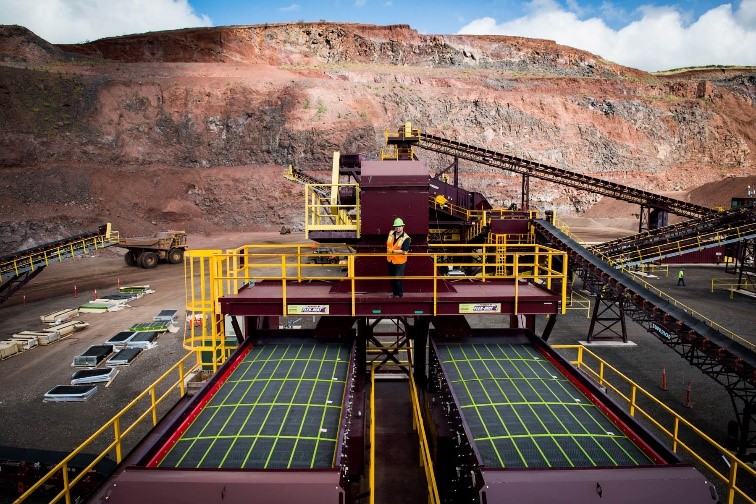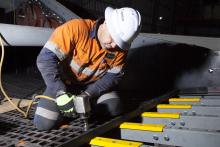
Selecting the right high quality screening media can make a huge difference to final aggregate product quality and a plant’s operating efficiency. Guy Woodford reports
Grace Pacific, a Kapolei (Oahu), Hawaii-based subsidiary of Alexander & Baldwin, has seen the benefits and the pitfalls associated with island operations. Its Makakilo Quarry was established in 1973 and is located on the face of a hill known as Pu’u Makakilo. For more than 30 years the quarry has provided a third of the island’s overall aggregate production, and 70% of the Grade A basalt aggregate necessary for infrastructure and construction projects on Oahu.
A vertically integrated company, Grace Pacific also produces asphalt and provides road construction and paving services. Having a local source of quality aggregate for its own hot mix plants has been beneficial not only for the company but also for the residents of the island, by eliminating the shipping impacts on the environment and associated freight costs. However, due to the geographical location of Oahu, aggregate reserves are limited.
In recent years, as the permitted reserves of Grade A aggregate diminished at the Makakilo Quarry, Grace Pacific faced a dilemma. It could either import quality aggregate material from the western continental US or Canada, which would increase the cost of necessary infrastructure projects on the island more than three-fold, or it could begin the process of permitting additional reserves on the island. Grace Pacific chose the latter. As part of its commitment to providing the residents of Oahu with a viable source of high-quality aggregate the company minimised its impact on the surrounding community, and invested US$40 million in state-of-the-art plant upgrades that went online in 2013.
Less than two years before the new plant startup, Grace Pacific made a tough decision to upgrade the screening operation on its old plant. The company brought in a screening expert from
“We first talked to Major Wire at CONEXPO-CON/AGG in 2011,” said Boyd Nobriga, Makakilo Quarry manager. “We decided to bring Jimmy in to do a Screen Maintenance Seminar, and he offered to do a Plant Audit while he was here. We were having some issues with our screens at the time. We had carryover in the product and we were experiencing screen breakage. We wanted to clean that up and see what we could gain in production.”
Siler’s plant audit indicated common screening issues such as the lack of crown bar rubber, damaged or worn clamp rails and the use of wedges instead of screen bolts. He offered some solutions, and also recommended replacing some of the plant’s woven wire screens with Flex-Mat, High-Performance Vibrating Wire Screening Media. Grace Pacific took Siler’s recommendations, and repaired the decks to install the premium screening media.
“We upgraded the old plant because we wanted to take Jimmy up on his claim. He said we’d get 30 percent longer wear life and 30 percent more production,” said Nobriga, adding that the plant experienced more than a 40 percent increase in production, and had no subsequent shutdowns for screen breakage through the remainder of the original site permit.
The new plant consisted of new primary, secondary and finishing stage operations, located in the lower pit to keep them out of sight from neighbouring communities. Grace Pacific’s new plant is a premium, automated, cutting-edge installation that can be completely operated wirelessly from a tablet. After Major Wire Industries showed Grace Pacific how to improve its screening operation on its old plant, the company chose to use Major’s premium screening media throughout its entire operation.
“Over the past four years we have worked with Major Wire Industries exclusively, implementing the High-Performance Vibrating Wire Screening Media whenever and wherever possible. The Flex-Mat product has been a game changer for Grace Pacific. They saw how it accelerated the stratification process, allowing more material to pass through all the decks, more accurately, keeping the specification right on target," said Siler.
Grace Pacific has implemented the Screen Maintenance procedures and best practices learned by attending Major Wire’s Screen Maintenance Seminars, resulting in a more efficient operation. Siler said: "Implementing the changes on the old plant showed the Grace Pacific maintenance staff that common screening errors can be prevented while conducting the installation and maintenance routine. This knowledge has now been carried to the new plant and the Grace Pacific Maintenance Crew has the new plant running like clockwork!”
Nobriga concluded: “We have learned a lot from Major and have experienced the same benefits from our new plant. The current vibrating wire screens have been running for three years now and delivering way above our expectations.”
“When you bid for new clients in the Western world, synthetic or polyurethane screening media is always a topic incorporated in a discussion over new plants. The demand is always to improve performance, capacity and lifetime,” says Claes Larsson, global product manager – Screening Media & Lining Solutions at Metso,
“In other parts of the world, for instance Thailand, it’s mostly a wire cloth [screening media] territory. A lot of the screening media choice is also driven by what type of rock is being processed.
“We do work a lot with the mining industry as well, and our business is split 50-50 [between mining and construction/quarrying], but the growth we see at the moment is in mining.”
Larsson said a lot of work has gone into improving the compatibility of Metso’s modular screening media with the company’s comprehensive screening model range, including its PREMIER screens.
“I’ve worked in crushing and screening for 25 years, and screening exclusively for 20 years, and this is the first time we [screening media and screening departments] have developed something very closely together: screening media and screens with the same components, modules, strips and side and crossbeam linings. Examples of this can be seen with the PREMIER ES horizontal screens and the CVB inclined screens. It means customers can use the screening media across their PREMIER screen range.”
Over the next few years, Larsson believes that the European and other key global regional markets will move on from tailor-made screens and screening media to standardised screens and modular synthetic screening media, as favoured by customers in North America.
“I see the quarrying market for synthetic screening media moving more and more away from polyurethane tension mats to snap on standardised modules that you attach. It means less components to stock and it’s less weight to carry when you change a screen’s screening media. For example, a tension mat on a big screen could weigh, maybe, 75kg. Now, you can use 10 modules weighing 6 to 8 kilos each. It means less work and strain on operators. One man could add smaller modules himself, but to haul a big tension mat to the screen would take two to three people or a crane.
“To get the right end product is the Number One thing in quarrying – regardless of what kind of screening media you have,” adds Larsson. “What you gain with synthetic screening media is its lifetime. You can run much longer production cycles, you can operate the plant with less interruptions, can rely on the performance and output, and can better schedule maintenance. You can also produce more material.”






